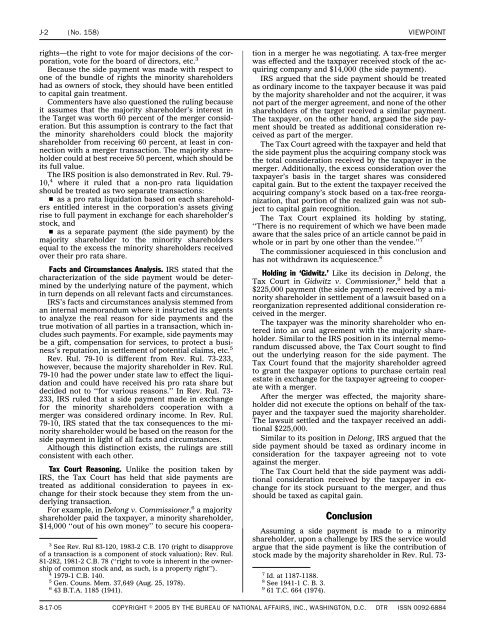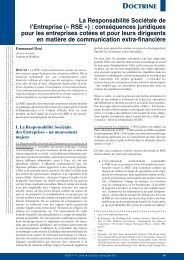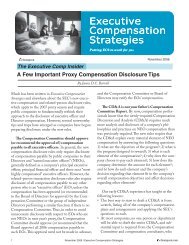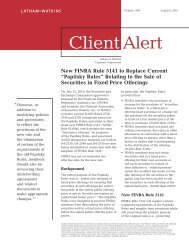XPP-PDF Support Utility
XPP-PDF Support Utility
XPP-PDF Support Utility
You also want an ePaper? Increase the reach of your titles
YUMPU automatically turns print PDFs into web optimized ePapers that Google loves.
J-2 (No. 158) VIEWPOINT<br />
rights—the right to vote for major decisions of the corporation,<br />
vote for the board of directors, etc. 3<br />
Because the side payment was made with respect to<br />
one of the bundle of rights the minority shareholders<br />
had as owners of stock, they should have been entitled<br />
to capital gain treatment.<br />
Commenters have also questioned the ruling because<br />
it assumes that the majority shareholder’s interest in<br />
the Target was worth 60 percent of the merger consideration.<br />
But this assumption is contrary to the fact that<br />
the minority shareholders could block the majority<br />
shareholder from receiving 60 percent, at least in connection<br />
with a merger transaction. The majority shareholder<br />
could at best receive 50 percent, which should be<br />
its full value.<br />
The IRS position is also demonstrated in Rev. Rul. 79-<br />
10, 4 where it ruled that a non-pro rata liquidation<br />
should be treated as two separate transactions:<br />
s as a pro rata liquidation based on each shareholders<br />
entitled interest in the corporation’s assets giving<br />
rise to full payment in exchange for each shareholder’s<br />
stock, and<br />
s as a separate payment (the side payment) by the<br />
majority shareholder to the minority shareholders<br />
equal to the excess the minority shareholders received<br />
over their pro rata share.<br />
Facts and Circumstances Analysis. IRS stated that the<br />
characterization of the side payment would be determined<br />
by the underlying nature of the payment, which<br />
in turn depends on all relevant facts and circumstances.<br />
IRS’s facts and circumstances analysis stemmed from<br />
an internal memorandum where it instructed its agents<br />
to analyze the real reason for side payments and the<br />
true motivation of all parties in a transaction, which includes<br />
such payments. For example, side payments may<br />
be a gift, compensation for services, to protect a business’s<br />
reputation, in settlement of potential claims, etc. 5<br />
Rev. Rul. 79-10 is different from Rev. Rul. 73-233,<br />
however, because the majority shareholder in Rev. Rul.<br />
79-10 had the power under state law to effect the liquidation<br />
and could have received his pro rata share but<br />
decided not to ‘‘for various reasons.’’ In Rev. Rul. 73-<br />
233, IRS ruled that a side payment made in exchange<br />
for the minority shareholders cooperation with a<br />
merger was considered ordinary income. In Rev. Rul.<br />
79-10, IRS stated that the tax consequences to the minority<br />
shareholder would be based on the reason for the<br />
side payment in light of all facts and circumstances.<br />
Although this distinction exists, the rulings are still<br />
consistent with each other.<br />
3 See Rev. Rul 83-120, 1983-2 C.B. 170 (right to disapprove<br />
of a transaction is a component of stock valuation); Rev. Rul.<br />
81-282, 1981-2 C.B. 78 (‘‘right to vote is inherent in the ownership<br />
of common stock and, as such, is a property right’’).<br />
4 1979-1 C.B. 140.<br />
5 Gen. Couns. Mem. 37,649 (Aug. 25, 1978).<br />
6 43 B.T.A. 1185 (1941).<br />
Tax Court Reasoning. Unlike the position taken by<br />
IRS, the Tax Court has held that side payments are<br />
treated as additional consideration to payees in exchange<br />
for their stock because they stem from the underlying<br />
transaction.<br />
For example, in Delong v. Commissioner, 6 a majority<br />
shareholder paid the taxpayer, a minority shareholder,<br />
$14,000 ‘‘out of his own money’’ to secure his cooperation<br />
in a merger he was negotiating. A tax-free merger<br />
was effected and the taxpayer received stock of the acquiring<br />
company and $14,000 (the side payment).<br />
IRS argued that the side payment should be treated<br />
as ordinary income to the taxpayer because it was paid<br />
by the majority shareholder and not the acquirer, it was<br />
not part of the merger agreement, and none of the other<br />
shareholders of the target received a similar payment.<br />
The taxpayer, on the other hand, argued the side payment<br />
should be treated as additional consideration received<br />
as part of the merger.<br />
The Tax Court agreed with the taxpayer and held that<br />
the side payment plus the acquiring company stock was<br />
the total consideration received by the taxpayer in the<br />
merger. Additionally, the excess consideration over the<br />
taxpayer’s basis in the target shares was considered<br />
capital gain. But to the extent the taxpayer received the<br />
acquiring company’s stock based on a tax-free reorganization,<br />
that portion of the realized gain was not subject<br />
to capital gain recognition.<br />
The Tax Court explained its holding by stating,<br />
‘‘There is no requirement of which we have been made<br />
aware that the sales price of an article cannot be paid in<br />
whole or in part by one other than the vendee.’’ 7<br />
The commissioner acquiesced in this conclusion and<br />
has not withdrawn its acquiescence. 8<br />
Holding in ‘Gidwitz.’ Like its decision in Delong, the<br />
Tax Court in Gidwitz v. Commissioner, 9 held that a<br />
$225,000 payment (the side payment) received by a minority<br />
shareholder in settlement of a lawsuit based on a<br />
reorganization represented additional consideration received<br />
in the merger.<br />
The taxpayer was the minority shareholder who entered<br />
into an oral agreement with the majority shareholder.<br />
Similar to the IRS position in its internal memorandum<br />
discussed above, the Tax Court sought to find<br />
out the underlying reason for the side payment. The<br />
Tax Court found that the majority shareholder agreed<br />
to grant the taxpayer options to purchase certain real<br />
estate in exchange for the taxpayer agreeing to cooperate<br />
with a merger.<br />
After the merger was effected, the majority shareholder<br />
did not execute the options on behalf of the taxpayer<br />
and the taxpayer sued the majority shareholder.<br />
The lawsuit settled and the taxpayer received an additional<br />
$225,000.<br />
Similar to its position in Delong, IRS argued that the<br />
side payment should be taxed as ordinary income in<br />
consideration for the taxpayer agreeing not to vote<br />
against the merger.<br />
The Tax Court held that the side payment was additional<br />
consideration received by the taxpayer in exchange<br />
for its stock pursuant to the merger, and thus<br />
should be taxed as capital gain.<br />
Conclusion<br />
Assuming a side payment is made to a minority<br />
shareholder, upon a challenge by IRS the service would<br />
argue that the side payment is like the contribution of<br />
stock made by the majority shareholder in Rev. Rul. 73-<br />
7 Id. at 1187-1188.<br />
8 See 1941-1 C. B. 3.<br />
9 61 T.C. 664 (1974).<br />
8-17-05 COPYRIGHT 2005 BY THE BUREAU OF NATIONAL AFFAIRS, INC., WASHINGTON, D.C. DTR ISSN 0092-6884







